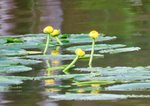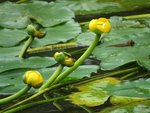Many who are unfamiliar with spatterdock will call it a waterlily, but while it's in the same botanical family with waterlilies, it’s not a true waterlily.
Join our family of readers for as little as $5 per month and support local, unbiased journalism.
Already have an account? Log in to continue. Otherwise, follow the link below to join.
Please log in to continue |


LABELLE- Often called yellow pond lily, or just lilies, spatterdock is readily spotted in the water all around LaBelle. It is one of the most common aquatic plants in Florida, and can be found in most of the 67 counties,
“It has sort of a tropical look to it, but it's actually found over most of the eastern and central United States and even into Canada,” said local botanist and historian, Janine Phelps. “Native Americans also used spatterdock to stop bleeding and as an analgesic, or pain reliever. A tea made from the root has also been used to treat dysentery and diarrhea.”
“Spatterdock is widely used in landscaping, in wet gardens and along the edges of ponds and lakes. It is a perennial and flowers in spring and summer,” Phelps went on. “It is is a member of Nymphaeaceae, the waterlily family. Another common name for it is cow lily. In fact, many unfamiliar with spatterdock will call it a waterlily, but while it's in the same botanical family with waterlilies, it’s not a true waterlily.”
Waterlilies have flowers that open fully, while spatterdock produces yellow flowers that appear half-open. The flowers are open, they just don't look like it.
“Spatterdock has large heart-shaped leaves and a huge root system that moors the plants to the bottom. The flowers can have stems as long as six feet,” Phelps explained. “It’s flowers attract pollinating insects, while ducks and other water birds will eat the seeds.”
Spatterdock can be a valuable plant for fish and wildlife habitat providing food, shelter, and a place of breeding for a host of Florida’s native animals. The leaves provide shade, shelter, and cover from predators for many invertebrates that fish use for food. It's also a host plant for two types of moths, the yellow waterlily borer and the waterlily moth. Also, many species of dragonflies and damselflies can be seen laying eggs in the middle of each rounded leaf.
Spatterdock seeds are eaten by water fowl and other birds. Muskrat, beaver, and porcupine will eat the rhizomes and deer have been known to graze on leaves and flowers. Many invertebrates spend their entire life cycle on spatterdock with varying effects on the plant.
Historical evidence shows that many humans also once commonly used the rhizome (root) by cooking or even drying and grinding it into flour for baking.
“Yes, spatterdock is edible, in the strictest sense of the word. It won't kill you or make you sick, but doesn't taste very good, either,” Phelps joked. “It is believed that Calusa Indians, the ones that lived along this stretch of the Caloosahatcher River, would eat the root, after being soaked and boiled to remove bitterness. It tastes a lot like really strong liver and onions. The seeds, are pretty tasty though.”
It has also been ground for use medically as a poultice. Leaves and roots contain tannin that was used for dying and tanning.
“Protecting water quality throughout Lake Okeechobee and the Caloosahatchee can help control overabundant aquatic plants and is best accomplished by limiting, reducing, or redirecting the input of external nutrients (primarily nitrogen and phosphorous) from waterways,” said Phelps, “Potential nutrient sources include runoff from numerous sources including lawns and golf courses, agricultural fields, waste from livestock, pets and wildlife, and poorly functioning septic systems.”
“Reductions can be achieved by planting low-maintenance lawns, applying less fertilizer near waterways, using phosphorous-free fertilizer, maintaining vegetated riparian buffers to absorb nutrients, increasing bank stability to reduce soil erosion, and maintaining proper aeration and good water flow,” Phelps suggested. “Not addressing the nutrient issues will lead to a perpetual need to control plant growth.”
This important plant has many uses, but overgrowth can cause a multitude of problems as well. There is a delicate balance, as with all environmental systems, that must be achieved in order for this plant, and Florida’s natural ecosystems, to survive.